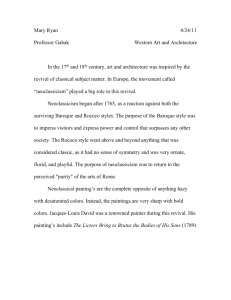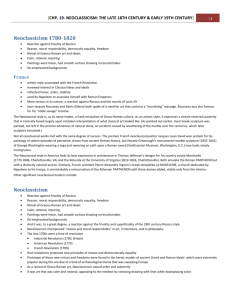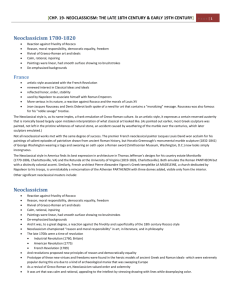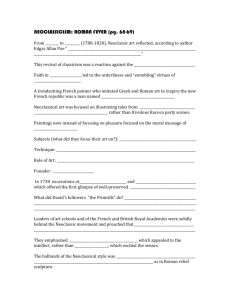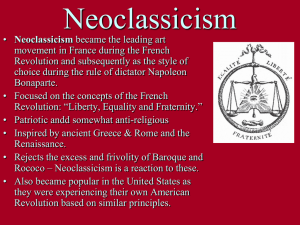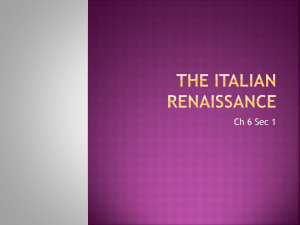NeoClassicism - Currituck County Schools
advertisement
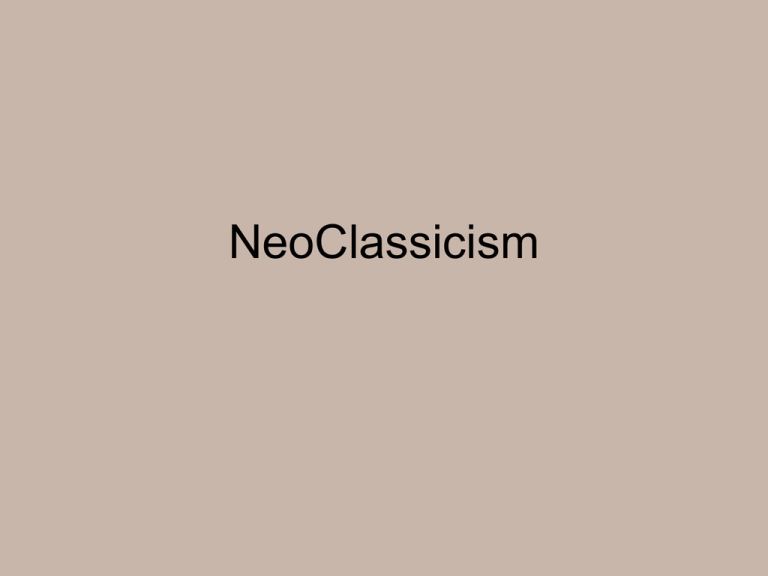
NeoClassicism Background • • • • Mid 1700’s to mid 1800’s Dominant areas France and England Arose as a reaction against the excesses of Rococo art Scientific and archeological discoveries such as buried Roman cities of Herculaneum (1738) and Pompeii (1748) • Engravings and publications on the individual and chronological art periods in Greek and Roman history • Renewed interest in Greek antiquity…not just Roman • German scholar Johann Joachim Winckelmann prompted sculptors to embrace the idealized approach Greeks had to figure sculpture…create an archetype for figure sculpture Characteristics • Earlier works heavily influenced by Renaissance, Baroque and Rococo artworks but with a rational shift • 1780’s saw a shift in style in France….revolution influenced style to similar of Roman themes of stoicism, nationalism and heroism • Outline and linear design • Historical accuracy especially in architecture and costume • Simplicity in form and setting Jacques-louis David (1748 1825) • Born in France • Earliest training in a Rococo style under Boucher…short lived • 1775-80 studied in Italy and adopted a more patriotic style • Believed in the revolution and it almost had him executed…saved by wife • Ended in Brussels Napolean Crossing the Alps Marat Assassinated 1793 Angelica Kauffmann (1741 1807) • • • • • Swiss born Prodigy in art and music at early age (11) Trained in Italy Supportive father Met Sir Joshua Reynolds and helped found the Royal Academy in 1769 • Moved to England and married fellow artist Antonio Zucchi Virgil reading the ''Aeneid'' to Augustus and Octavia , 1788 Parting of Abelard and Heloise Before 1780 Study for the portrait of the Marchione ss of Townshen d and son Jean-auguste-dominique Ingres (1780 - 1867) • Born in France • 1797 Father prompted him to go to Paris to study under David • Won the prix de Rome in 1801 Characteristics • Idealization of human forms • Elongated backs • Drawing techniques reflected in works Jupiter and Thetis Vicomtess Othenin d'Haussonvi lle, née LouiseAlbertine de Broglie Study Antonio Canova • b. 1757 Possagno, Italy, d. 1822 Venice, Italy • Sculptor • Worked predominantly in marble • Created plaster models to scale prior to carving works • Took several trips to Rome to study • Became the most celebrated sculptor of NeoClassical period Characteristics • Earlier works had emotion from Baroque and appealed to wealthy patrons from Venice • Grandeur • Physically idealized • Mythological themes • Portraits often blended mythology with reality • Created full scale plaster models of sculptures prior to starting marble incarnations Plaster model for Cupid and Psyche, 18th century (1794) Plaster Theseus and the Minotaur 1781-83 Marble Perseus with the Head of Medusa, 1804–6 Architecture • Heavily influenced by archeological discoveries of ancient Greek/Roman structrues • Classic Greek/Roman temple epitomy of pure architectural style sought after for neoclassicism Characteristics • Clean, elegant lines • Uncluttered appearance • Long, flat rows of free standing columns for structural support • Massive buildings • Flat, horizontal roofs • Lack of towers or domes • Symmetrical flat facades with lack of ornamentation • Geometrically patterned gardens Notable architects • • • • Karl Friedrich Schinkel John Soane Charles Cameron Juan de Villanueva Juan de Villanueva Prado Museum 1785 Karl Friedrich Schinkel The Altes Museum ("Old Museum") in Berlin John Soane Moggerhangerhouse • • • • • • • • • • Resources http://www.all-art.org/history356.html http://wwar.com/masters/movements/neoclassicism.html http://www.jeanaugustedominiqueingres.org/ http://www.abcgallery.com/B/boucher/boucher51.html http://s7d2.scene7.com/is/image/Fathead/3713118_ingresapotheosis-homer-18x24smart_prod?layer=comp&wid=640&hei=640&fmt=jpeg&qlt=95,1&op _sharpen=1&resMode=bicub&op_usm=0.5,0.2,0,0&iccEmbed=0&b gc=0xdedede&bgColor=0xdedede http://www.artble.com/artists/jean_auguste_dominique_ingres http://musee.louvre.fr/oal/psyche/psyche_acc_en.html http://www.artcyclopedia.com/artists/canova_antonio.html http://www.wga.hu/frames-e.html?/bio/c/canova/biograph.html http://www.worldofleveldesign.com/categories/architecture/neoclassi cal/neoclassical_architecture.php Critique:19th century http://www.google.com/imgres?imgurl=http://e dgarlowen.com/a55/b7966.jpg&imgrefurl=http ://edgarlowen.com/sculpture.shtml&usg=___0 p4aLN1LnLAHiPzKEn9Ij0bFXs=&h=1272&w= 706&sz=36&hl=en&start=4&zoom=1&tbnid=s q4ozMKCSNgROM:&tbnh=150&tbnw=83&ei= cDdOT5SCGYaztwf1m6WlCA&prev=/images %3Fq%3DNeoclassical%2Bsculpture%26hl% 3Den%26sa%3DX%26rls%3Dcom.microsoft:* :IESearchBox%26rlz%3D1I7ADSA_enUS458%2 6tbm%3Disch&itbs=1 Comparative Dominique Ingres “triumph of Homer” oil on canvas Francois Boucher “Apollo revealing his divinity to the Shephardess” Romanticism Background • 1760-1870 approx • Reaction against NeoClassicism style not the appreciation of antiquities • Began in N Europe with a rejection of technical restrictions calling for perfection • Influenced by literature of time • Explored the interdisciplinary nature of art: music, dance, etc • Orientalism had huge influence upon works • Exploration of the individual, exotic, folk origins, ethnic origins, and occult. • Break from strict guidelines of Neoclassicism Characteristics • Concerned with the personal, emotional and transcendental experience • Nature’s beauty intrinsic to works • Senses over reason and emotion over reason • Imagination • Struggle between heavenly ideals and earthly desires • Included the American Hudson River School of landscape painters (1835-1870) Eugene Delacroix • 1798-1863 • Born in France • Use of color and technique influenced Impressionists and Post Impressionist artists • Historical themes as well as visit to Morocco dominated works • Created more than 850 paintings • Technique often employed the application of colors not blended, yet from a distance, a sense of whole color….kick start to Impressionist technique The Sultan of Morocco and his Entourage Andromeda c. 1852 Lion Hunt 1854 Francisco Goya y Lucientes • • • • • • • • • • 1746-1828 Born in Spain Young age trained with local artist Went to Italy to finish studies Came back, painted frescoes in a Rococo style for local church…made him Worked as “cartoon” painter for textile company…where his genre of everyday life depictions started Became portrait painter for aristocracy and eventually for king….elected court painter France came in….brutal conflict…depicted in a series of etchings published posthumously “The Disasters of War” French court painter Pardoned when Spain regained control….but eventually lost favor and voluntarily left spain for France Characteristics of work • Color technique that applied color in strokes next to each other instead of blended • Keen observations of human nature • A realistic approach to theme 1783 portrait of Count Floridabana 1st important commission Los Caprichos • 1797 works on 80 etchings under the guise of exploration into witchcraft practices in Spain • It is believed that this is a veil for the true subject….inquisition practices by powerful and unchecked Church Los Caprichos plate 77 • Text caption (below) from the "Prado" etching version: • "The way of the world. The people laugh and play bullfightering with each other. He who yesterday played the bull plays today the toreador. Chance rules the game and assigns the parts according to her caprices." The sleep of reason produces monsters 1797-98 Etching with aquatint Isabel de Porcel 1804-05 Time Les Vieilles c. 1810-12 Disasters of War • http://www.napoleonguide.com/goyaind.ht m The Shootings of May Third 1808 1814 Burial of the Sardine c. 1816 Resources • http://www.arthistoryarchive.com/arthistory /romanticism/arthistory_romanticism.html • http://www.ibiblio.org/wm/paint/auth/delacr oix/lion-hunt.jpg • http://www.eugenedelacroix.org/ • http://www.ibiblio.org/wm/paint/auth/goya/ • http://www.eeweems.com/goya/index.php Critique JMW Turner Slavers throwing overboard the Dead and Dying - Typhoon coming on ("The Slave Ship") 1840; Oil on canvas Comparative Summary Angelica Kauffman The Family of the Earl of Gower 1772 • John Constable Salisbury Cathedral from the Bishop's Grounds c. 1825
